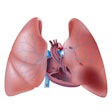Coronary artery calcium (CAC) as calculated from CT scans was by far the best predictor of cardiovascular disease in individuals with chronic kidney disease (CKD), just as it is in the population at large, concludes a new study in the Journal of the American Society of Nephrology.
The retrospective analysis included patients from the Multi-Ethnic Study of Atherosclerosis (MESA). Despite concerns about whether the calcium-phosphate metabolism of individuals with CKD would influence predictors of cardiovascular disease, CAC beat out carotid intima-media thickness and the ankle-brachial index for predicting events.
Each measure improved cardiovascular risk prediction in subjects with CKD, but the greatest improvement was observed with CAC score, wrote the investigators from Johns Hopkins University and several other U.S. academic centers (JASN, August 21, 2014).
"The performance of coronary calcium to improve predictions of cardiovascular disease is well-studied in the general population, but even though there is a unique calcium-phosphate metabolism in individuals with chronic kidney disease, our study results confirm that coronary calcium can be useful to improve prediction," said epidemiologist and lead author Dr. Kunihiro Matsushita.
A heavy burden
Depending on location, as much as 10% to 15% of the population is burdened with chronic kidney disease, and approximately half of those with CKD die of cardiovascular disease, making it a critical concern among CKD patients, Matsushita and colleagues wrote.
Coronary artery calcium is a promising measure for predicting adverse cardiac events, as it has proved a reliable predictor of cardiovascular disease and stroke in the general population. But it has not been tested in CKD patients specifically -- "a population with unique calcium-phosphate homeostasis" that could alter the development of atherosclerosis, according to the authors. How could poor kidney function change the atherosclerotic risk profile?
"The kidneys play an important role in controlling both serum calcium and serum phosphate," Matsushita said. "For example, vitamin D, a hormone that controls both calcium and phosphate, is activated in the kidneys. If the kidneys don't function well, that control can also be impaired. Also, hyperparathyroidism is a well-known complication among patients with kidney disease, so patients with kidney disease tend to have more calcium regardless of their underlying atherosclerotic risk profile."
In addition, some papers have reported that traditional risk factors such as lipids and blood pressure may not perform as well as in the general population, he said.
Coronary calcium may not correlate well with the severity of coronary disease in the chronic kidney disease population, Matsushita and colleagues wrote. Previous studies also lacked subtypes of cardiovascular disease such as heart failure and peripheral artery disease in their analysis, which are more prevalent and clinically serious in individuals with chronic kidney disease.
"To our knowledge, no study has looked specifically at the performance in the CKD population," Matsushita said.
The current study looked at CAC along with carotid intima-media thickness (IMT) and ankle-brachial index (ABI) in terms of their associations with cardiovascular disease, i.e., coronary heart disease, stroke, heart failure, and peripheral artery disease. The researchers examined how these measures affected cardiovascular risk prediction among individuals with CKD in the general population.
A secondary aim was to compare the findings in those with chronic kidney disease to those without the condition, according to the authors.
The study included 6,553 subjects (age, 45-84 years) from MESA who did not have prior cardiovascular disease; of this group, 1,284 had chronic kidney disease. During a median follow-up of 8.4 years, the investigators found 650 cardiovascular events, including coronary heart disease (n = 387), stroke (n = 138), heart failure (n = 190), and peripheral artery disease (n = 70). Of the 650 events, 236 were in subjects with chronic kidney disease.
The researchers associated each subclinical measure -- CAC, intima-media thickness, and ankle-brachial index -- with cardiovascular outcomes, and they rendered each measure's predictive ability using hazard ratios (adjusted for Framingham predictors). CAC had a higher adjusted hazard ratio than carotid intima-media thickness or ankle-brachial index in subjects with and without CKD, the group found.
| Cardiovascular disease prediction in CKD subjects | ||
| Subclinical measure | Adjusted hazard ratio | 95% confidence interval |
| Coronary artery calcium | 1.69 | 1.45-1.97 |
| Carotid intima-media thickness | 1.12 | 1.00-1.25 |
| Ankle-brachial index | 1.20 | 1.08-1.32 |
Participants with CKD were less likely to be current smokers than those without CKD, and the researchers found no substantial racial or ethnic differences between the two groups.
CAC showed more improvement for predicting cardiovascular disease in all statistics compared with carotid intima-media thickness and ankle-brachial index, regardless of CKD status, according to the authors. In the CKD group, C statistics for predicting cardiovascular disease improved significantly with CAC added.
"Despite the concern about the performance of CAC among those with CKD because of unique calcium-phosphate metabolism, the association with global [cardiovascular disease] was strongest for CAC in this population, which translated to the most evident improvement in [cardiovascular disease] prediction over IMT and ABI as shown in the general population," they wrote.
When each cardiovascular disease subtype was analyzed separately, CAC was better than the other measures for coronary heart disease and heart failure prediction, regardless of the CKD status of the subject. However, none of the three measures had much effect on stroke prediction, and ABI best improved peripheral artery disease prediction overall.
CAC's apparent superiority to IMT and ABI for predicting global cardiovascular disease is consistent with previous reports that looked at coronary heart disease and stroke, the authors wrote.
The use of CAC does comes with some caveats, such as ionizing radiation, which both IMT and ABI avoid; also, the latter two exams may be more widely available, Matsushita and colleagues noted.
In the end, all three measures, CAC, ABI, and IMT, improved cardiovascular risk prediction in subjects with CKD, but CAC did the best job, the group concluded.


















